Have you been struggling to keep your Monstera plant alive and healthy? Are its leaves turning yellow, despite all of your best efforts? You’re not alone! Many people have experienced the same issue with their Monsteras. Fortunately, there are a few reasons why this is happening and some simple solutions that can help get it back on track. In this article, we’ll explore nine common causes of yellowing in Monsteras and how to fix them. So if you’ve been wondering why your beloved Monstera has turned yellow, read on for more information!

Contents
- 1 Why Is My Monstera Turning Yellow?
- 2 What Does Overwatered Monstera Look Like?
- 3 How Do You Know If Monstera Has Root Rot?
- 4 Should You Water Monstera Right After Repotting?
- 5 Should I Remove Yellow Leaves From Monstera?
- 6 Can Yellow Monstera Leaves Turn Green Again?
- 7 What Deficiency Causes Yellowing Of Leaves?
- 8 Conclusion
Why Is My Monstera Turning Yellow?
Yellowing leaves in plants isn’t always a sign of imminent doom – sometimes they just need a bit of extra care or attention to restore their lush green color. If your Monstera’s leaves are starting to turn yellow, don’t panic! It could simply be due to one (or more) of these nine issues listed below. With the right solution, you should be able to nurse it back to health in no time at all.
1. Overwatering
If your Monstera plant leaves are turning yellow, it could be due to overwatering. Excess water can easily cause the leaves of a Monstera plant to turn yellow as they don’t need much water in comparison to other plants. This is because too much water can lead to root rot which causes the yellow leaves that you may have noticed on your Monstera plant.
When examining your Monstera plant for signs of root rot and excess water, look out for wilted or discolored stems and roots. The soil should also feel damp and if possible move the pot around slightly – if there is an excessive amount of water, this will likely come out from the drainage holes at the bottom of the pot. If you find that there is indeed too much water in the pot, then take action immediately by emptying some of it out and allowing the top layer of soil to dry before watering again.
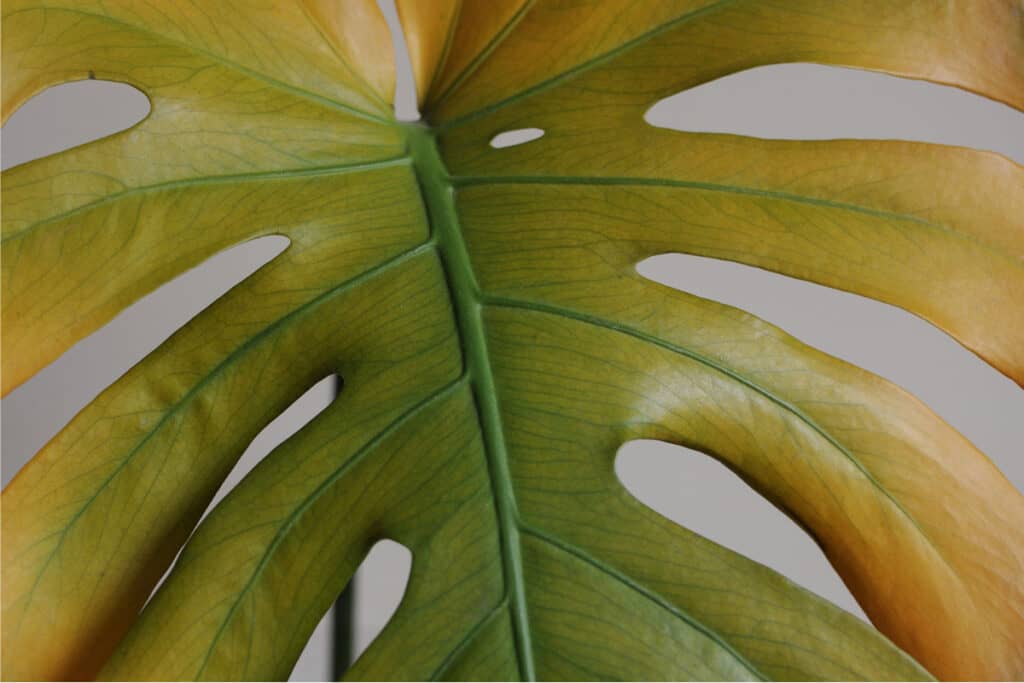
2. Underwatering
Underwatering is another common cause of your Monstera turning yellow. If you are not giving the plant enough water, the leaves will start to turn yellow and dry out as it tries to preserve what little moisture there is in its system.
Signs of underwatering include drooping or wilting leaves, brown patches on foliage, and crisp edges along leaf margins. As with overwatering, if you catch this issue early enough then it can be reversed—but make sure to take action quickly! Water your Monstera thoroughly until the soil is saturated and let any excess drain away.
TIP: Keep an eye out for spider mites – these tiny pests often thrive when conditions are too dry for other insects. If you notice webs forming around stems or small bugs moving about on leaves then act quickly by spraying down both sides of each leaf with insecticidal soap.
3. Excessive Light
When it comes to Monstera turning yellow, excessive light could be the culprit. Too much direct exposure to sunlight can cause a Monstera’s leaves to turn yellow and brown. When this happens, the plant is actually trying to protect itself from too much sun by reducing its exposed surface area as much as possible.
If you notice your Monstera starting to turn yellow, check where it’s located in your home or office. Is it near a window that gets a lot of direct sunshine? If so, move it back away from the window or place some kind of screening material like sheer curtains over the window for protection. You may also want to consider getting an indoor grow light setup if you don’t have enough natural lighting indoors.
4. Nutrient Deficiency
One primary reason your monstera may be turning yellow is nutrient deficiency. This can happen if the soil doesn’t have enough nitrogen, potassium, magnesium and other essential nutrients for proper growth. Plants need these minerals to produce healthy foliage, so when they’re lacking any of them, it can cause leaves to turn yellow or even brown.
To ensure that your monstera has all the necessary nutrients it needs, you should regularly fertilize its soil with a balanced fertilizer. Be sure not to overdo it though – too much fertilizer can damage roots and make matters worse! Additionally, check the soil pH level every few months and adjust as needed with either lime or sulfur powder.
5. Monstera Turning Yellow After Repotting
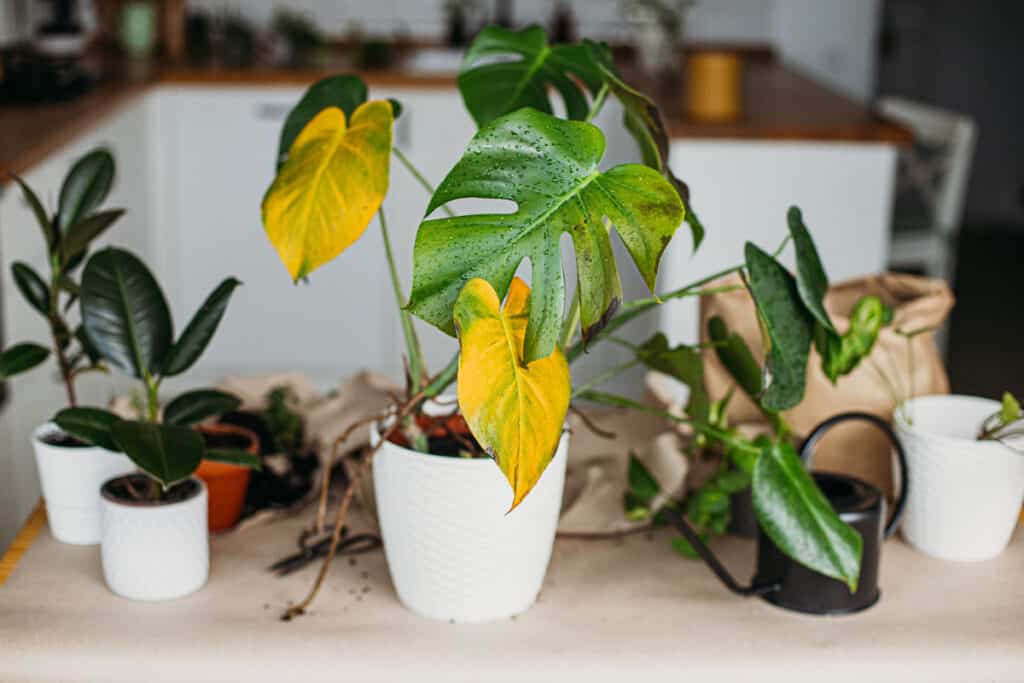
Repotting is a necessary part of your monstera’s life, but it might also be the cause of its yellowing. Usually, when you repot your plant, there are a few things that can go wrong and lead to yellow leaves. Let’s take a look at some common culprits and how to fix them.
First off, if you’re using soil that doesn’t have enough nutrients or has poor drainage, this could be causing your monstera’s leaves to turn yellow. To solve this problem, replace the soil with one that offers better nutrient-rich properties and adequate drainage for excess water. Additionally, ensure that you’re not overfeeding the plant – too much fertilizer can strip away essential minerals from the roots!
Another potential issue when repotting is root damage. If you’ve been too rough while transplanting the monstera into its new pot, it might suffer root trauma which will result in wilted or yellowed leaves as they become deprived of vital nutrients such as iron and nitrogen. To repair any damaged areas on the plants’ roots use gentle techniques like trimming back any dead sections before placing it into its new pot.
Lastly, overwatering after repotting may also make your monstera turn yellow due to an abundance of moisture in their environment. This causes rot to set in quickly so try to keep an eye on how often you’re watering the plant during this period. Make sure you check whether the top layer of soil is dry before adding more water – if it isn’t then wait until it dries out before giving your monstera any more H2O!
6. Humidity Issues
Humidity can play a big role in your Monstera’s health, and if the humidity isn’t just right, it could be why your plant is turning yellow. If you suspect that this is the case, there are some steps you can take to solve it.
First off, make sure that the area where your Monstera is located has good ventilation and air circulation, as stagnant air could be contributing to the problem. Consider investing in an indoor humidifier or misting your plant regularly throughout the day with distilled water — both of these methods will help increase moisture levels around the plant.
7. Monstera Turning Yellow From Age
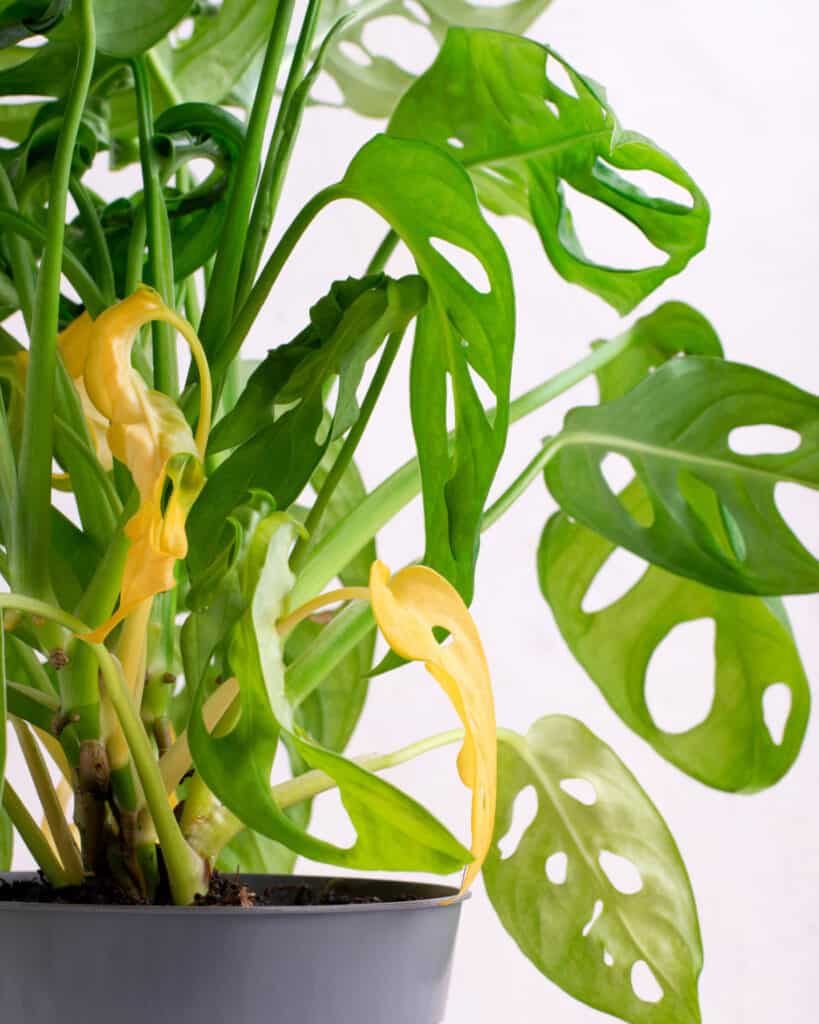
Age is a common cause of Monstera turning yellow. As plants age, the leaves often start to suffer from discoloration and curling. This occurs because as plants get older their cellular structures weaken, causing them to become more vulnerable to environmental factors like temperature or humidity levels. The result can be yellowing of the leaves in an otherwise healthy plant.
Fortunately, this type of yellowing isn’t necessarily fatal for your Monstera. It’s important to remember that all plants have lifespans; just like humans, they eventually reach a point where they’ve had enough sunlight and water, and it’s time for them to move on. To keep your Monstera going strong even into its golden years, provide it with plenty of indirect light and make sure that you’re watering it regularly but not too frequently.
If you notice any additional signs of stress such as wilting or irregular leaf edges, then it may be time to consider repotting your Monstera into a larger planter, which will give the roots some extra room to grow and help the plant take up more nutrients from the soil. Doing so should help restore some vibrancy back into those aging leaves!
No matter how old your Monstera might be, there are still plenty of ways you can ensure its health and longevity over time – by providing adequate lighting, avoiding overwatering, and occasionally changing out its pot for something bigger. With these simple steps in mind, you’ll be able to enjoy watching your beloved Monstera thrive through all stages of life!
8. Pests And Diseases
Pests and diseases can cause a Monstera to turn yellow. These issues are usually caused by insects like mealybugs or scale. It’s important to catch these problems early on as they can quickly spread throughout the plant if left untreated.
The first signs that pests and diseases may be causing your Monstera to turn yellow are yellowing leaves with spots, wilting stems, or white patches along the stem. If you notice any of these symptoms it’s best to remove infected leaves immediately and treat the remaining healthy parts of the plant in order to save it.
Treatment options for pests and diseases include removing affected areas manually, using insecticides such as neem oil spray, or applying fungicide solutions. Always make sure to follow instructions when applying treatments so you don’t accidentally harm your Monstera further. Additionally, consider repotting the plant into fresh soil which will help minimize potential pest infestations in the future.
9. Seasonal Changes
Seasonal changes can also cause your Monstera to turn yellow. As the temperature and light conditions change, so will the color of some leaves. While this is often harmless, it’s important to know what the signs and causes are for when you need to intervene.
Firstly, if a plant isn’t getting enough sun exposure or humidity levels drop too low, its leaves may start to fade from green to yellow. This could be an indicator that your Monstera needs more sunlight or higher humidity levels. To fix this issue, try moving the plant closer to a window where it can get plenty of indirect sunlight throughout the day and misting it regularly with water in order to increase humidity levels.
Secondly, if temperatures fall below 60°F (15°C), this could trigger leaf discoloration as well. In winter months especially, make sure your Monstera isn’t exposed to any sudden fluctuations in temperature which might lead to yellowing leaves. If necessary, move it away from colder drafts such as open windows or air vents.
Finally, plants go into dormancy during winter months regardless of their environment – they take a break while temperatures are cooler before coming back strong in springtime! During this period of rest, keep watering on a regular basis but don’t over-water otherwise root rot could occur; check for soil moisture every few days by poking your finger about 2 inches deep into the potting mix and adjust accordingly.
Taking these steps should ensure that your Monstera remains healthy no matter what season!
What Does Overwatered Monstera Look Like?
It’s important to know what an overwatered monstera looks like, so you can take steps to prevent it from happening. So, what does an overwatered monstera look like?
First off, the leaves of your Monstera will start to yellow and feel limp. The edges may be brown or black as well. This is a sign that there’s too much water in the soil for your plant – its roots need air as well as moisture to stay healthy. You’ll also notice root rot which causes soggy soil and foul odors. Additionally, you may see mold growing on the surface of the potting mix in extreme cases.
If any of these signs are present then you should act quickly to save your Monstera! Ensure that your watering schedule is appropriate – don’t water too frequently or let the soil remain wet for extended periods of time. Make sure the drainage holes at the bottom of the pot are not blocked; this allows excess water to escape, preventing root rot and other issues caused by overwatering. If possible, repot into fresh soil with good drainage properties such as perlite or coco coir mixed with organic material like compost or peat moss.
How Do You Know If Monstera Has Root Rot?
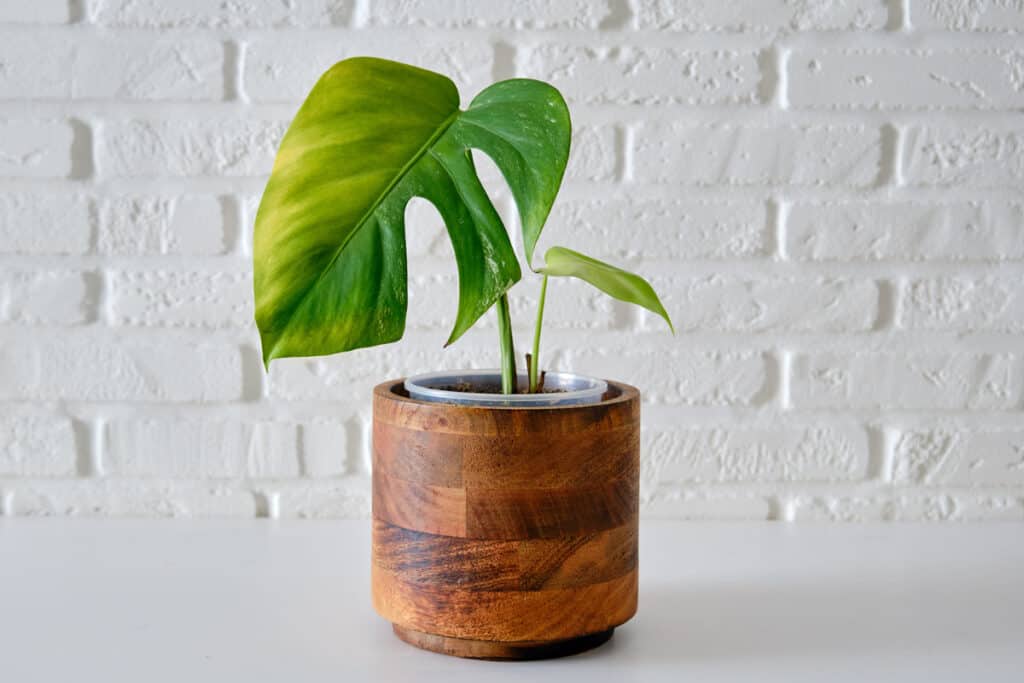
Root rot is an issue that can occur with Monstera plants if they are overwatered. It can be identified by the plant’s yellowing leaves, wilting stems, and rotting roots. Root rot will prevent water from reaching the rest of your Monstera and can ultimately lead to its death. To avoid root rot in your Monstera, it’s important to know how much water you should give it and when.
Fortunately, there are several signs which indicate whether or not root rot has set in. For example, brown spots on the stem may appear near the soil line; this indicates a lack of oxygen due to too much moisture around the roots. The leaves may also turn yellow and curl up as they do when overwatering occurs. If these symptoms persist despite proper care, it’s likely that your Monstera has root rot.
To treat root rot in your Monstera, first remove any affected parts – including branches and sections of damp soil – then repot into fresh potting mix with improved drainage capabilities. You’ll want to use sterilized tools for disease prevention purposes, plus make sure that all old soil particles have been removed from the roots before repotting them into new soil so no fungus remains behind. Finally, ensure that you aren’t over-watering going forward by checking for dryness between each watering session using a moisture meter or finger test method. Doing so will help keep your Monstera healthy and discourage future issues like root rot from occurring again!
Should You Water Monstera Right After Repotting?
When it comes to repotting your Monstera, you may be wondering if you should water the plant right away. It’s an important question to ask because watering incorrectly can drastically affect the health of your Monstera.
First things first, do not water your Monstera immediately after potting it! This is especially true if you have just transplanted it into a larger pot – overwatering in this situation can cause root rot. Instead, wait until the soil has had time to settle around the roots before giving any additional moisture. If possible, try to hold off on watering for at least one week after repotting; this gives the roots plenty of time to adjust and acclimate to their new home.
Should I Remove Yellow Leaves From Monstera?
Overall, removing yellowed leaves from a Monstera should only occur after assessing what caused them to turn yellow in the first place. If necessary steps have been taken to rectify whatever issue was causing discoloration but no improvements have been seen yet then yes, those affected leaves should be removed while taking care not to hurt their neighboring healthy ones.
Can Yellow Monstera Leaves Turn Green Again?
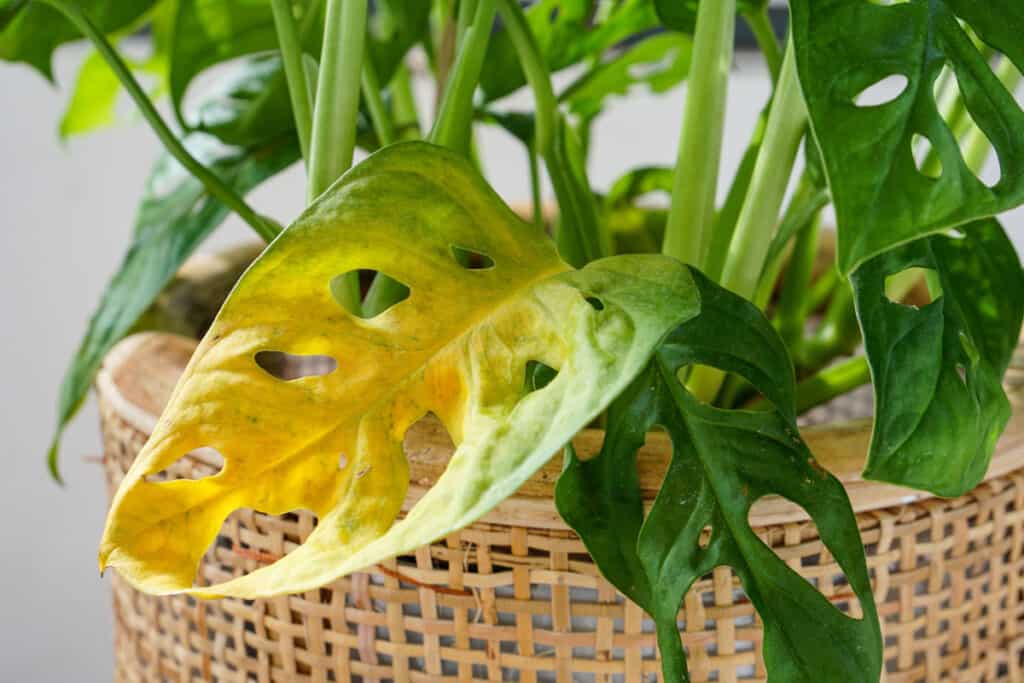
Yellow monstera leaves may not turn green again due to a number of reasons. One possible reason is that the yellowing is a result of a disease or pest infestation that has damaged the leaf tissue, making it unable to recover. Another possible reason is that the yellowing is a symptom of a more serious issue, such as a lack of proper care or a nutrient deficiency, that has caused the plant to become stressed and unable to recover.
It’s also possible that the yellowing is due to the leaf is aging and it’s natural for the leaf to change color and eventually fall off. In this case, the leaf will not turn green again as it’s reaching the end of it’s life cycle.
It’s important to identify the cause of yellowing and address it properly to help the plant recover.
What Deficiency Causes Yellowing Of Leaves?
A number of nutrient deficiencies can cause yellowing of leaves in plants, including monstera. Some common deficiencies that can cause yellowing include:
- Nitrogen deficiency: Nitrogen is essential for the production of chlorophyll, the pigment that gives leaves their green color. A lack of nitrogen can cause the leaves to turn yellow.
- Potassium deficiency: Potassium is important for the overall health and vitality of the plant. A deficiency can cause yellowing between the veins of the leaves.
- Iron deficiency: Iron is necessary for the production of chlorophyll and the overall health of the plant. A lack of iron can cause the leaves to turn yellow.
- Phosphorus deficiency: Phosphorus is important for the overall health and vitality of the plant. A deficiency can cause leaves to turn purple or red, and then yellow and dry.
- Magnesium deficiency: Magnesium is an essential element for plant growth and is necessary for the production of chlorophyll. A deficiency can cause yellowing between the veins of the leaves.
It’s important to note that yellowing of leaves can also be caused by environmental factors such as lack of light or over-watering, so it’s important to consider all possible causes when trying to diagnose the problem.
Conclusion
In conclusion, it’s important to understand why your monstera is turning yellow and how you can fix the issue. Many things can be contributing factors, like overwatering or underwatering, excessive light, nutrient deficiency, and repotting.
If you are consistently watering your plant appropriately and providing enough sunlight then a nutrient deficiency could be causing the yellow leaves. It’s best to use a fertilizer specifically made for house plants every few weeks so that your monstera has all of the necessary nutrients for healthy growth.
Finally, if your monstera’s yellow leaves have already begun to appear don’t panic! With some careful attention you may still be able to save them by cutting off any dead parts of the leaf and giving them proper care from now on. Don’t forget that once these issues are addressed there is always a chance that the plant will not have yellow leaves again!
